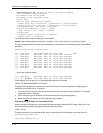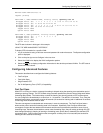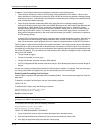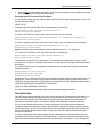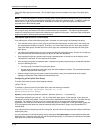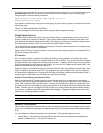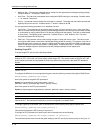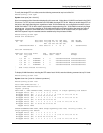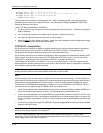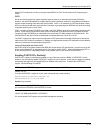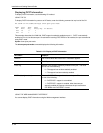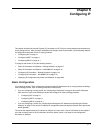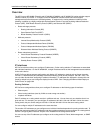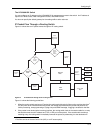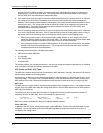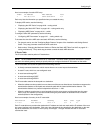
Installation and Getting Started Guide
Untagged Ports: (S4) 17 18 19 20 21 22 23 24
Untagged Ports: (S6) 1 2 3 4 5 6 7 8 9 10 11 12 13 14 15 16
Untagged Ports: (S6) 17 18 19 20 21 22 23 24
Tagged Ports: None
This example shows information for port-based VLAN 1, which is the default VLAN. Notice that a message
indicates that the VLAN is in the single STP domain. Also notice that the SINGLE-SPANNING-TREE-VLAN
contains all the ports in the device.
USING THE WEB MANAGEMENT INTERFACE
1. Log on to the device using a valid user name and password for read-write access. The System configuration
dialog is displayed.
2. Click on the Single checkbox next to Spanning Tree to place a checkmark in the box.
3. Click Apply to apply the change to the device’s running-config file.
4. Select the Save
link at the bottom of the panel. Select Yes when prompted to save the configuration change
to the startup-config file on the device’s flash memory.
PVST/PVST+ Compatibility
HP devices that are configured to support a separate spanning tree in each port-based VLAN can interoperate
with Cisco devices that are running Per VLAN Spanning Tree (PVST) or PVST+, Cisco proprietary STP
implementations that support separate spanning trees in each port-based VLAN.
An HP device configured to run a separate spanning tree in each port-based VLAN automatically enables PVST/
PVST+ support on a port if that port receives an STP BPDU with PVST/PVST+ format. You also can enable
PVST/PVST+ support statically as well as display PVST/PVST+ information for each port.
The information in this section is for reference. If you are running PVST/PVST+ on the Cisco devices and the
default support for separate spanning trees in each VLAN on the HP devices, then no configuration is necessary
for the devices to share spanning tree information.
NOTE: If you plan to use the PVST/PVST+ support, do not use VLAN 1. PVST+ uses VLAN 1 as a single STP
broadcast domain and thus uses a different BPDU format than for other VLANs.
PVST
Each spanning tree (that is, each instance of STP) has one device called the root bridge. The root bridge is the
control point for the spanning tree, and sends STP status and topology change information to the other devices in
the spanning tree by sending BPDUs to the other devices. The other devices forward the BPDUs as needed.
The format of an STP BPDU differs depending on whether it is a Cisco PVST BPDU or an HP BPDU. HP and
Cisco devices also can support single STP BPDUs, which use another format.
• An HP device configured with a separate spanning tree in each VLAN sends BPDUs in standard IEEE 802.1D
format, but includes a proprietary four-byte tag. The tag identifies the VLAN the BPDU is for.
• A Cisco device configured for PVST sends the BPDUs to multicast MAC address 01-00-0C-CC-CC-CD. If the
device is configured for PVST+, then the device sends BPDUs for all VLANs except VLAN 1 to 01-00-0C-CC-
CC-CD. The device sends BPDUs in VLAN 1 to 01-80-C2-00-00-00, the single STP address (see below and
“PVST+”).
• An HP device configured for single STP (IEEE 802.1Q) sends untagged BPDUs to the well-known STP MAC
address 01-80-C2-00-00-00.
NOTE: Cisco devices can be configured to interoperate with devices that support IEEE 802.1Q single STP, but
the devices cannot be configured to run single STP.
HP’s PVST support enables HP and Cisco devices that have separate spanning trees in each VLAN to
interoperate. The HP PVST support is automatically enabled when a port receives a PVST BPDU and does not
require configuration on the HP or Cisco device.
5 - 20



